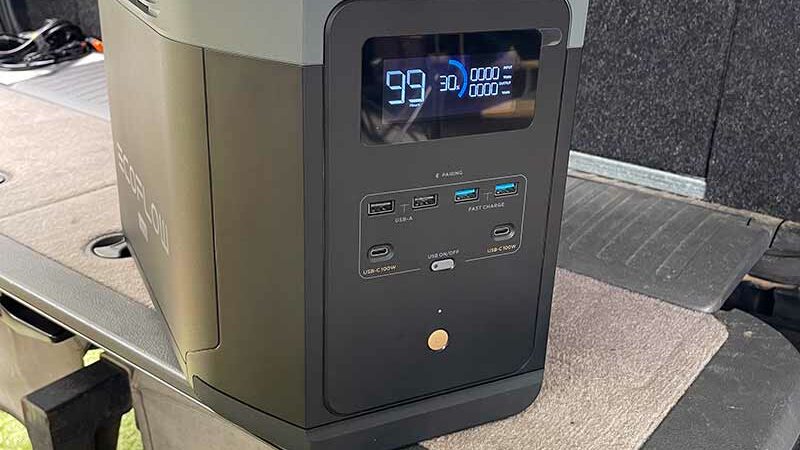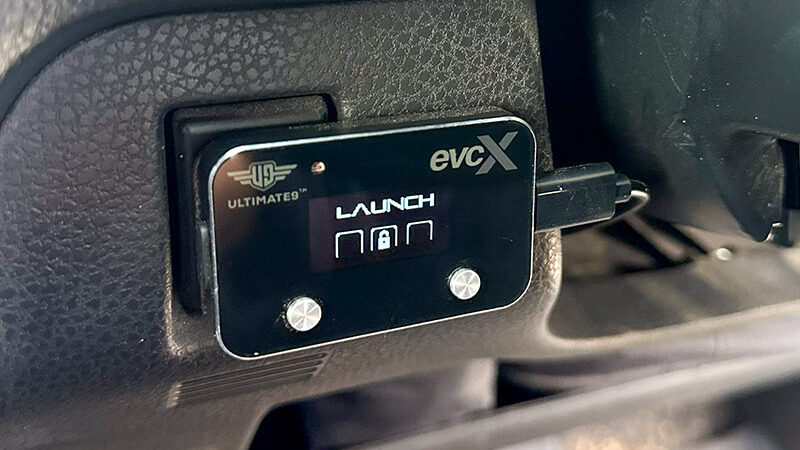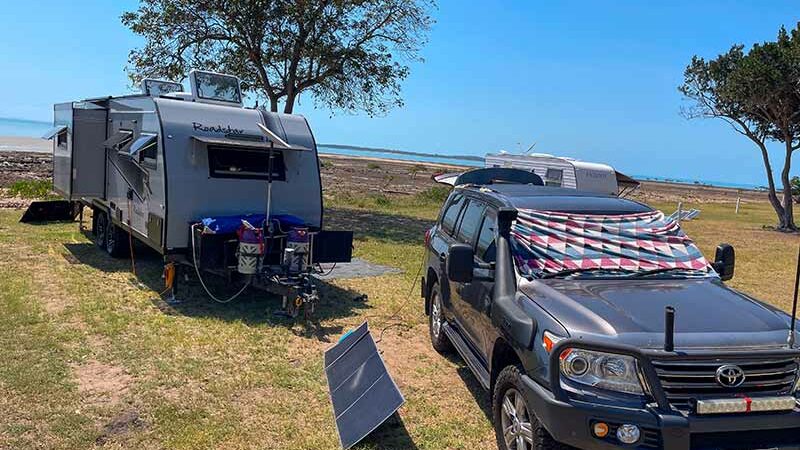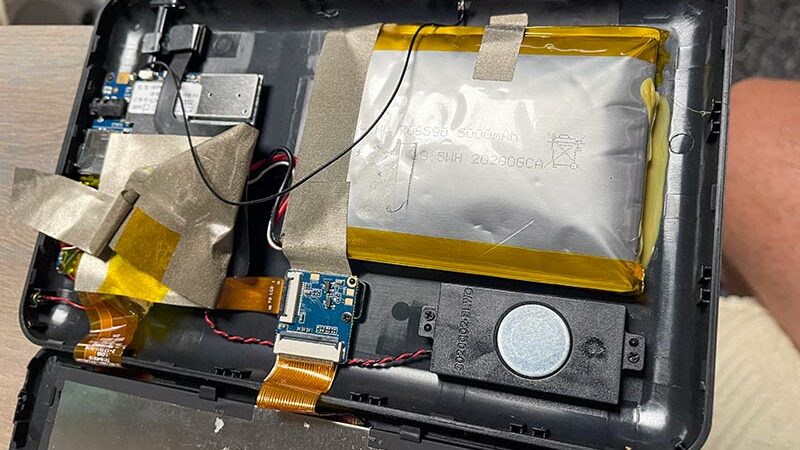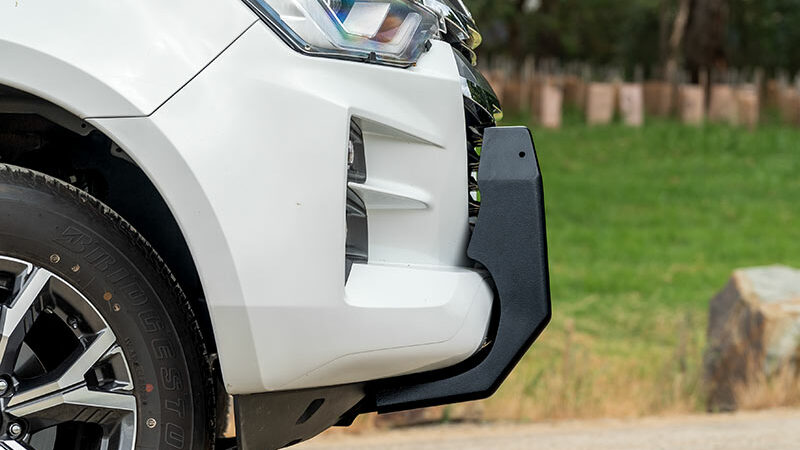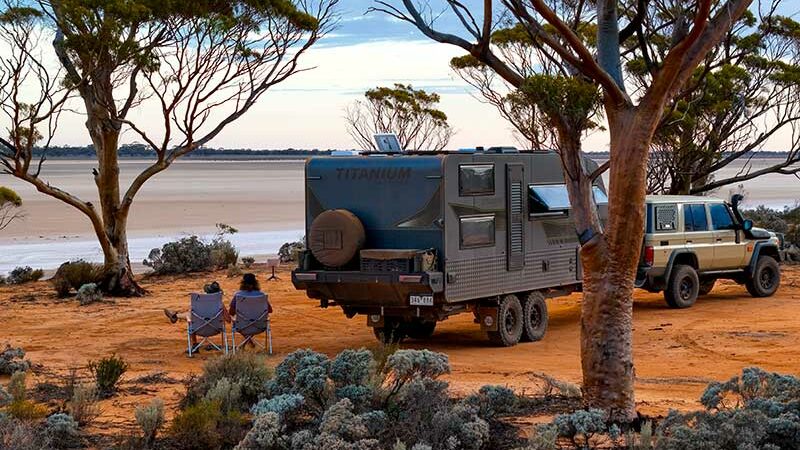Generator Comparison: Solar vs Diesel
Six years ago, I was deep into planning our transition to a permanent life on the road in our caravan. We wanted to do as much free-camping as possible so we had to have a solid 12V electrical system with plenty of solar and some backup power supply should the sun not shine. Normally, I would have opted for a petrol-powered generator but I was keen to look into an alternative. One of the emerging technologies at the time was portable lithium power stations or, as they are more commonly known, solar generators.
Back then, there weren’t many options available, especially units with enough stored power to be useful. The ones that would be suitable were quite heavy and based on lithium-ion battery technology. They were also very expensive. I put aside my ambitions and just kept my old faithful petrol generator.
Today, the situation is vastly different. The technology for solar generators has advanced leaps and bounds to the point where I believe they are a viable alternative to petrol generators for the vast majority of caravanners.
To prove the point, I’ve been comparing my Yamaha 1000iS petrol generator to an EcoFlow Delta 2, one of the most modern and capable solar generators available today. Here’s what I’ve discovered.
WHAT IS A SOLAR GENERATOR?
In a nutshell, solar generators are like a high-tech battery box. They are based on a high-capacity lithium battery with an inbuilt 240V inverter, AC and DC charging as well as an MPPT solar charge controller. Everything you need to power all your devices away from mains power in one easy-to-transport package.
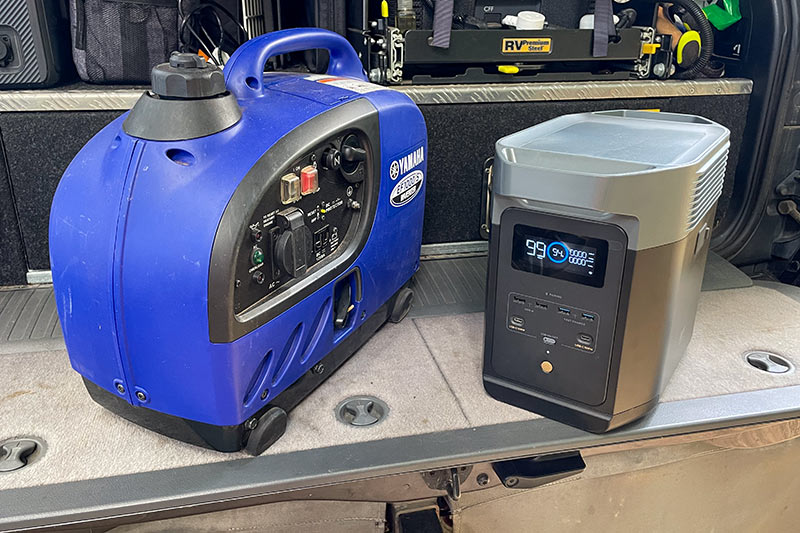
They are available in a wide range of capacities and output capabilities. The EcoFlow Delta 2 I’ve been testing has a 1024Wh lithium iron phosphate (LiFePO) battery and a 1800W 240V inverter that can deliver up to 2200W in X-Boost mode and a staggering 2700W surge output.
Compare that to my Yamaha 1000iS, which has a nominal output of 900W, a peak output of 1000W and, with a full tank of fuel, can theoretically provide around 3500 to 4000Wh of continuous power.
COMPARING APPLES WITH BANANAS
I should point out that the reason I chose these two devices for this comparison was more by accident than good management.
My primary use for a generator is to recharge the 400Ah of lithium batteries we have in our caravan. While that may seem to be a fairly large battery bank, the reality is we use quite a bit of those batteries in our normal day-to-day living when off-grid. We have a large compressor fridge and a myriad of smart devices connected to the internet via a Starlink system. Our power use is quite high and even with excellent solar charging at our disposal, if we were to get three days in a row of bad weather, we could be struggling to recharge our batteries. The Yamaha 1000iS was the smallest and lightest generator available with sufficient capacity to power the 40A (700W) battery charger in our caravan.
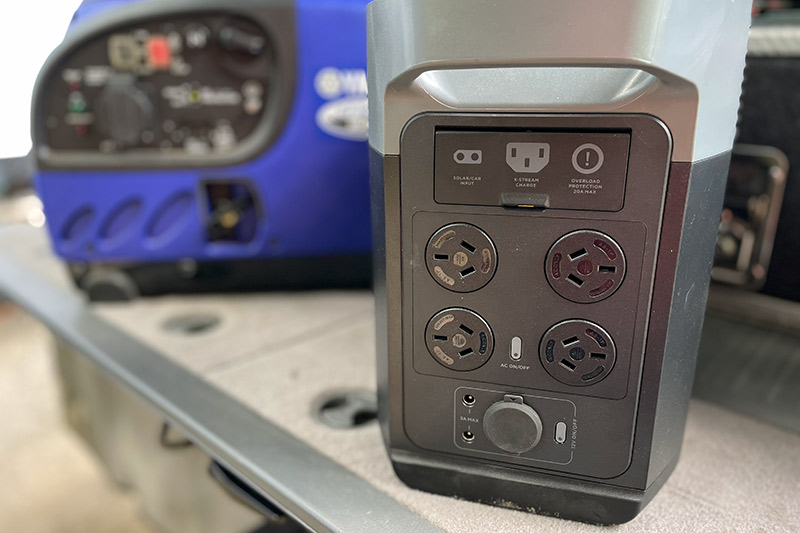
The Delta 2 was what EcoFlow supplied to us for testing purposes. It was pure luck that it happened to be of similar size and weight to our Yamaha. The Delta 2’s 1024Wh storage capacity is the minimum I would have considered for our particular requirements.
In order to determine whether a solar generator, like the Delta 2, can perform the same functions as a petrol generator, we need to look at each application individually and evaluate how each unit performs those specific functions.
RECHARGING BATTERIES
We typically drain our 400Ah (4800Wh) caravan batteries by up to 25 per cent overnight. That’s 1200Wh I need to obtain the next day in order to fully recharge the batteries. Using my petrol generator to power the 700W battery charger takes about three hours and will use about half to two-thirds of the fuel in the tank. So I can get about two full recharge cycles out of one tank. Any more and I’ll need to refill the generator.
The EcoFlow Delta 2 has 1024Wh to give so, at best, I’ll get my batteries back up to about 90 per cent state of charge. Still, that isn’t too bad. It’s certainly enough to get me well out of trouble and keep me going for at least another day.
Now, I know I can’t just fill up the ‘fuel tank’ like I do with the petrol generator. I need to recharge the Delta 2 somehow. We generally don’t sit around camp all day. We like to go out and explore the area. That means heading off in the car. I can recharge the Delta 2 using the car’s 12V outlet or, for faster charging, I can connect it directly to the car’s battery and it will recharge at about 200W from the alternator, meaning it can be fully recharged in about four to five hours of driving. If that’s not fast enough, there is the option to install a DC-DC transformer such as the Victron 12/24-20 and charge the Delta 2 at up to 400W, halving recharge times again.
RUNNING HIGH-POWER 240V APPLIANCES
A lot of caravanners use their generators to power high-wattage appliances such as air fryers, induction cooktops, coffee machines, and just about anything you can think of. Unfortunately, my Yamaha is only good for 900W continuous load, which limits it to powering our microwave. If I wanted to power any of our other appliances, I’d need to get a much bigger and heavier generator.
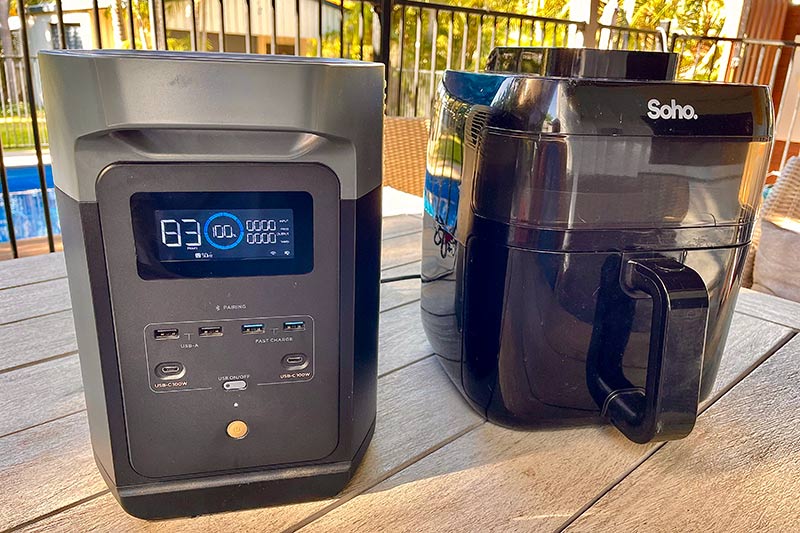
The Delta 2 is a whole different story. Its 1800W pure sine wave inverter is a game-changer. This output level was unheard of in solar generators of this size and capacity. I’ve been able to run our coffee machine, induction cooktop, and even our 1400W air fryer on the Delta 2. And because we typically use these appliances for short periods of time, they don’t take that much out of the Delta 2’s battery. For example, I can cook three or four meals in our air fryer on a single charge.
To recharge the Delta 2, I can use one of my external solar panels or I can wait until I get to a powered site and recharge it then. But there’s another clever option that a lot of owners will appreciate.
If we have good solar charging weather, we typically recharge our van’s batteries before lunchtime. After that, we potentially have excess solar that is not being utilised. Now, I can plug the Delta 2 into our caravan’s inverter and, depending on the amount of solar we are producing, I can set the 240V charge rate on the Delta 2 anywhere between 200W and a staggering 1200W using excess solar energy we produce through the rest of the day.
RUNNING AN AIR-CON
A lot of caravanners buy a generator to run their air-conditioner while free-camping. I’ve never seen this as a priority and hence my Yamaha 1000iS is not capable of powering ours. To do so would require a higher-capacity model that would weigh much more, take up more space and I would need to carry a sufficient amount of fuel depending on how long I would want to run it for each day.
The EcoFlow Delta 2 is capable of powering our air-conditioner only for around 45 minutes at best. That’s not very long but it does give food for thought.
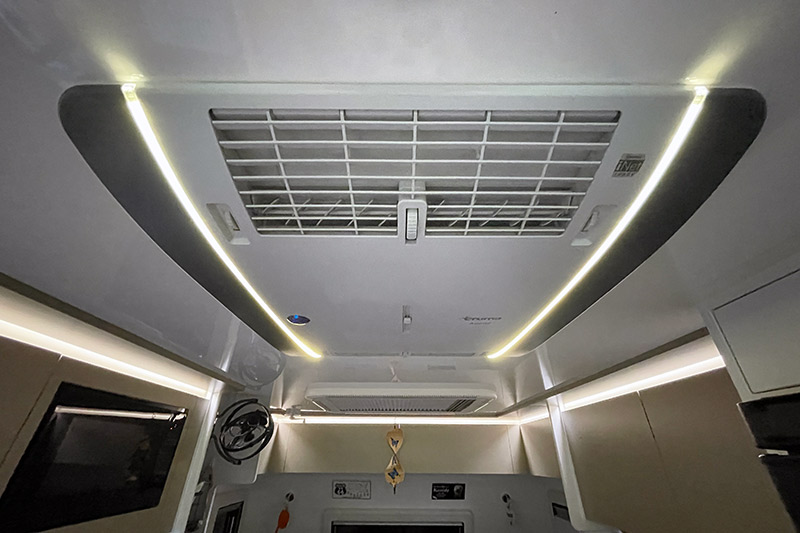
If you have to run your air-conditioner throughout the day, you’re much better off checking into a caravan park and using mains power to your heart’s content. But if you just want to run your air-conditioner to cool the caravan before going to bed, a solar generator would be a great idea.
Most camping grounds won’t allow you to run a generator much later than 7pm, certainly not after 9pm, which is when you might want to use it. A solar generator makes no noise, so you can run it any time of the day or night. If you have a larger capacity solar generator, say around 2000Wh, you could get around two hours of run time. That’s enough to take the edge off a warm caravan and allow you to get a good night’s sleep.
FINAL ASSESSMENT
Solar generators have certainly come a long way since I first started looking at them all those years ago. Their capabilities are such that, for the majority of caravanners, they present a very viable alternative backup power source to a petrol generator in almost every circumstance.
They are smaller and lighter than the equivalent petrol generator, you don’t have to carry extra fuel, and you can store them inside the cabin of your tow vehicle. They will power almost any appliance you can think of and you can use them any time of the day or night without disturbing your neighbours.
I’m not suggesting solar generators can do everything a petrol generator can do but, in my opinion, they come very close. They will even do some tasks their petrol cousins can’t.
From my perspective, the capabilities of the EcoFlow Delta 2, and other solar generators like it, are more than sufficient for our backup power needs. So much so that we simply do not need a petrol generator anymore.
The post Generator Comparison: Solar vs Diesel appeared first on GoRV.
